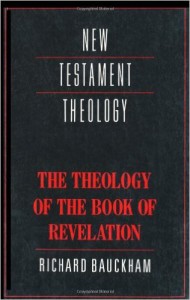The Theology of the Book of Revelation by Richard Bauckham
Introduction
Most interpretations of revelation in contemporary churches are concerned with the chronology of the book of Revelation. While this has benefits it is not the best approach. First because that was not the manner in which revelation was written. Revelation was not written with times and dates said in the text. Many of the Old Testament prophets were given a time oriented prophecy and somewhat given events to describe. All of them had the same purpose: to bring Israel to repentance. In the same way, Revelation has the purpose of not predicting events but to bring people to repentance. The Theology of the Book of Revelation does justice by presenting revelation as theological history rather than chronological history.
The approach to the book is topical rather than verse-by-verse exposition. The themes that are approached are done very well. Many of the complicated issues in Revelation are thoroughly addressed and tied to the purpose of the book. The purpose of the book for the church is to be a faithful witness in contrast to being part of the corrupt world. God’s sovereignty is also prevalent. This combination was made to ensure the Christians that were persecuted in the first century. Chapter by chapter, the author gives a precise image of God, the Trinity, the Church, and the world in which the churches in Revelation live. The book also addresses topics that are relevant today.
The Theology of the Book of Revelation
The book first addresses the genre of Revelation. Revelation is a book of prophecy but also an apocalyptic literature piece. The apocalyptic form is used to express the prophecy to the churches. Revelation differs from other apocalyptic literature for two reasons: (1) the imagery used in the visions is highly visual and imaginative, and (2) the proportion of visual symbolism. Furthermore Revelation is not pseudepigraphical.
Revelation is also a circular letter addressed to churches of the time and churches in general. Beyond just a circular letter, Revelation uses images from the present-day and the Old Testament. These are merged by John to present the church is a better hope than what the world presents. These images are the medium by which John tells his story. They are hyperbolic in nature and not to be taken to literally. Many times John merges two or more Old Testament images to form a new image that was intended to give hope to the fledging churches at a time.
Beginning with chapter 2 and continuing for the rest of chapter 6 the author addresses the theology in a systematic manner. The issues are extensive and rich with content and understanding. There was much thought put into this small book which is evident in these chapters. God is seen in Revelation is Trinitarian. The names of God (“Alpha and Omega”, “One who was, is, and is to come,” and “Lord Almighty”) are compared and given meaning in the context of Revelation. There is even a critique of Roman power. God in Revelation is contrasted with the world at the time. Rome’s power and prosperity are in battle with the faithful witness of Christian to follow God.
The attributes of God are discussed. His holiness transcendence and power are seen primarily in the throne room of chapters four and five of Revelation. God is also pictured as the Creator. Many times the creation is expressed in revelation as receiving vindication. Worship becomes a result of knowing the creative power of God. God’s faithfulness to creation shown in many verses but the primary application is to eliminate evil, restore people to God, and make all things “eschatologically new.” The flood narrative in Genesis is used to express the restoration creation. Chaos is made clear and perfect in the presence of God.
Jesus, His deity and His role in the future history is also addressed. The designations and the functions of Jesus which He does in the book of Revelation point to His deity. Statements about God and Jesus in chapters one, twenty-one and twenty-two are compared. These statements show the similarity of Jesus to God. Worship of Jesus which occurs in chapter five and is reserved for God, is explained. The overriding theme in the book is the concept that Jesus shares the deity of God.
There are three things in the book of Revelation the depict the role of Jesus to his followers: (1) messianic war, (2) eschatological exodus and (3) witness. In each case, it is shown that Jesus is the example for the churches to follow.
The church has been pictured as an army of martyrs. Their victory is shared in their sacrificial death, not through violence. The army is pure and their task will most certainly lead to martyrdom. As they faithfully follow Jesus and not conform to the world their fate is certain. So Revelation depicts this fate as something that is glorious. The death of the Christian living for Christ will receive eternal life in authority.
The purpose of the church is depicted in the scroll that Jesus is worthy to open. The purpose is to be a faithful witness. In each of the seal and trumpet judgments, the first four deal with the nature of the world, and the last two deal with the result on Christians. In each of the judgments the intent (that people repent) does not occur. Therefore in chapter eleven, the two witnesses must do their work. This is a picture of the church being a faithful witness. The 144,000 is a complete number and the census is “the new Israel” with Jesus at the head. They are killed for their witness. The next image is a “multitude in heaven.” This is the result of that witness – death and glory with God. This interesting interpretation by the author explains the reason for what looks like discontinuity in the text. Judgments are intervened by the faithful witness of the church in the hopes that nations will repent. The implication in the book is that the witness of the church has a better hope for repentance than the awesome judgment of God.
The book makes a progression from the role of the church to the battle that the church wages in this world. While the church is to be a faithful witness to the world it also has the obligation to adhere to the truth. This is the meaning of conquering in the letters in Revelation. There are many enemies of God in the book such as the unholy trinity, the beasts, and the city of Rome. While the world uses deceit, the church is to follow the truth. This implies resistance against the world system.
The victory of the church as described in the “harvest of the earth.” Two images emerge: the grain harvest and the winepress. The grain harvest is the positive image of conversion of the nations. The winepress harvest is the image of judgment upon the nations by God. The grain harvest is performed by Jesus, while the winepress harvesters conducted by the angels. The “Song of Moses” is interpreted in the book of Revelation. The eschatological exodus is the faithful witness of the church that helps the nations repent and acknowledge the true God. For this reason, the passage that interprets the “Song of Moses” is placed before the bold judgments and Revelation. There is shown a choice for the nations: repentance or judgments. The final victories portrayed as the idea of truth over error. The church is a witness to the truth. The imagery changes from a militaristic picture, to one of judgment. While the church was in a battle with the world to convey truth, Jesus leads the church into the millennium as Judge. The life in rule, which was contrasted between the faithful and the people the beast–– Is the subject the millennium. Satan and his dominion lose the rule and eventually life. Christians because of their faithful endurance game life and dominion.
The Holy Spirit is shown in the book of Revelation as well. He is defined as “the Seven-fold Spirit” and as “the Spirit.” He has a distinct role in Revelation. He displays the divinity to the churches, and He is the power that churches can use in being a faithful witness. Through the power of the Holy Spirit, the churches able to impact the world. This occurs to the power of truth and discernment. Again, just like Jesus and God, the Holy Spirit is contrasted with the roles of this Satanic Trinity in Revelation. The role that the Holy Spirit in the churches has history prophecy. Visions and oracles are given to help the church continue in its purpose –– to be a faithful witness. Prophecy prepares the church to be a witness to the world. But prophecy also speaks to the church, to the needs and problems that each separate church, and all churches main encounter.
Another thematic element in Revelation is the contrast between the “New Jerusalem” and Babylon. The New Jerusalem is the future hope of the church –– God’s reign and presence among His people. Many contrasts and comparisons are made between Babylon and the New Jerusalem. Jerusalem is also ladened with heavy symbolism. Images from the priests and the prophets of the Old Testament are displayed in the visual description of the city of New Jerusalem. The New Jerusalem is a place, a paradise for God provides eternal life. It is built with precious stones, and contains no temple for God is there. This place is not just a garden, but a city, the seat of the divine kingdom. The New Jerusalem is also a people. The people who will reside in the New Jerusalem are the covenant people of God. These include people and the nations. The New Jerusalem is also the home of God’s presence. Creation honors God, Christians reign with God and worship God, and God himself will provide all the needs of His children.
The book ends with a chapter that discusses the relevance of Revelation for today. There is a section that describes the nature of true prophecy, and the proper interpretation of Revelation for today. This final chapter deals with the doctrines of imminence and delay. The chapter ends with theological implications from the book of Revelation.
Conclusion
Many times passages in Revelation compared and contrasted to explain theological truths. I found this to be very helpful and I also noticed that it showed more information than verse-by-verse explanation could do. But more than that, this book address the truths of Revelation, namely that the church must experience tribulation, must be a witness to the world, and must adhere to the truth. Jesus is coming, but that does not mean that there is nothing to do. The church is the method through which God will bring repentance, even though judgment should do the same. Revelation is a book of judgment, but only on the unrepentant. Revelation is not a book of timelines, nor does it promote the idea of a safety net for Christians to avoid the world. Revelation forces the Christian to consider impacting the world for Christ. Revelation is positive in that the judgment is certain for the unrepentant, but victory is secure for the Christian. The world may deny God. But He will remain the same, and will continue His sovereign rule.













